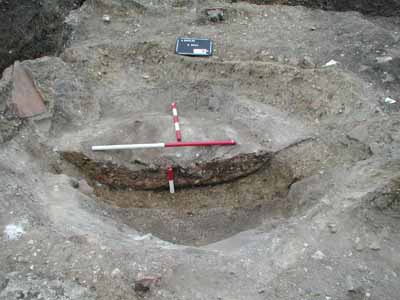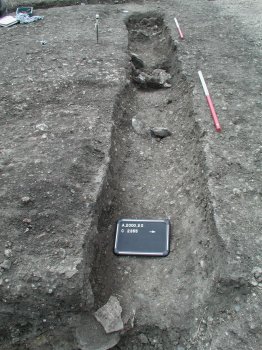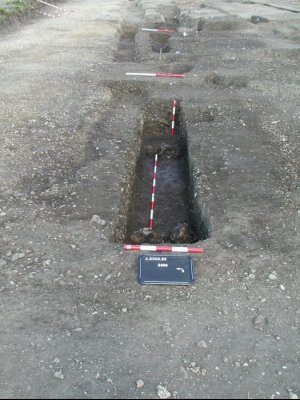The 2000
Season: Overview at Week 4
By Amanda Clarke |
As the excavation comes to the end of its 4th week, with only 2 weeks
left to go, excitement builds as we continue the excavation of the various
rubbish pits and shallow wells located to the rear of the streetfronts
and their aligned buildings. The number and quality of the finds being
excavated is impressive, ranging from enamelled brooches to bone, iron
and copper alloy pins, rings and other artefacts. The rubbish pit, which
contained the partially articulated skeletons of 2 dogs, has also produced
what may be either a bone or ivory handle for a knife, boasting an intricate
carving of 2 animals.
|
Most exciting of all however is the continued excavation of the
well in the north-west corner of the trench. In the gravel fills at its
base an entire pot has been recovered, of probable 2nd century AD date,
with a hole deliberately pierced in its side.This is not a lone example
of such a practice on this site: one of the wells excavated during the
1998 season contained a pierced flagon at its base, and the Victorians
recovered a deliberately pierced pewter jug from beneath the ogham stone
found in the shallow well cutting through the foundations of House 1.
|
.JPG) |
This practice may be seen as a deliberate ritual act,
the piercing of vessels normally used for carrying water, perhaps
as an act of propitiation to the gods. As I write, another entire
pottery flagon has been uncovered within this same well, lying below
and slightly to the north of the first. If they are, as is thought,
2nd century AD vessels found in a 4th century AD well, it does suggest
the curation of such vessels for more than a century before their
deliberate burial. |
| Elsewhere on site excavation of the construction levels
of Building 1 continue and an earlier brick built building is in
the process of being revealed, on the same alignment as House 1.
Of the 3 wells predating Building 1, 2 are currently being investigated
and we expect to begin the excavation of the third next week. It
is possible that the clay make-ups for a floor level to be associated
with Building 1 have slumped into an earlier well, as pictured (2604). |
 |
| The excavation of the construction levels of Buildings 5, 7 and 8 is
also well underway. A slot has been taken through the different road make-ups
and surfaces of the main north-south road through the Roman town. So far
this small excavation suggests at least 4 consecutive road surfaces with
their associated make-ups, and there may be more.Week 4 has been a busy
and productive week on site, |
and more excitement is foreseen for the next week with the continuing
excavation of the late Roman dark soils in the north of the site. It is
becoming more and more apparent that the east-west street frontage was
divided into small parcels of land, each of which may have been maintained
by a different property owner. The size of these parcels of land may have
altered over the late Roman period, as suggested by differing lengths of
boundary established and re-established over time. |
|
.JPG)


